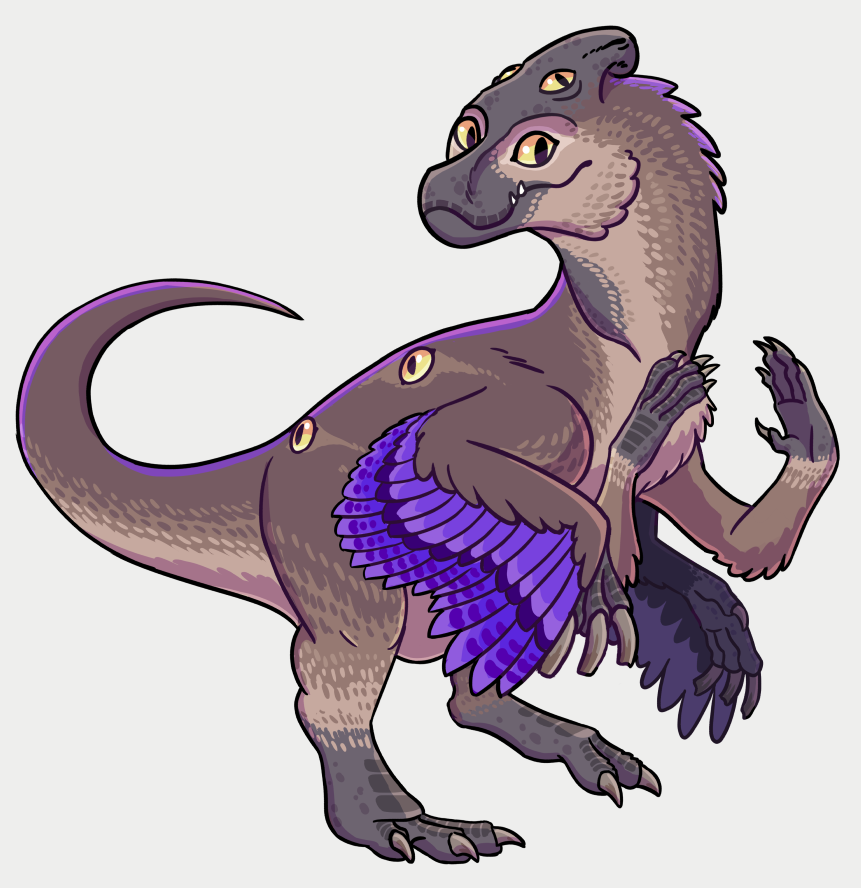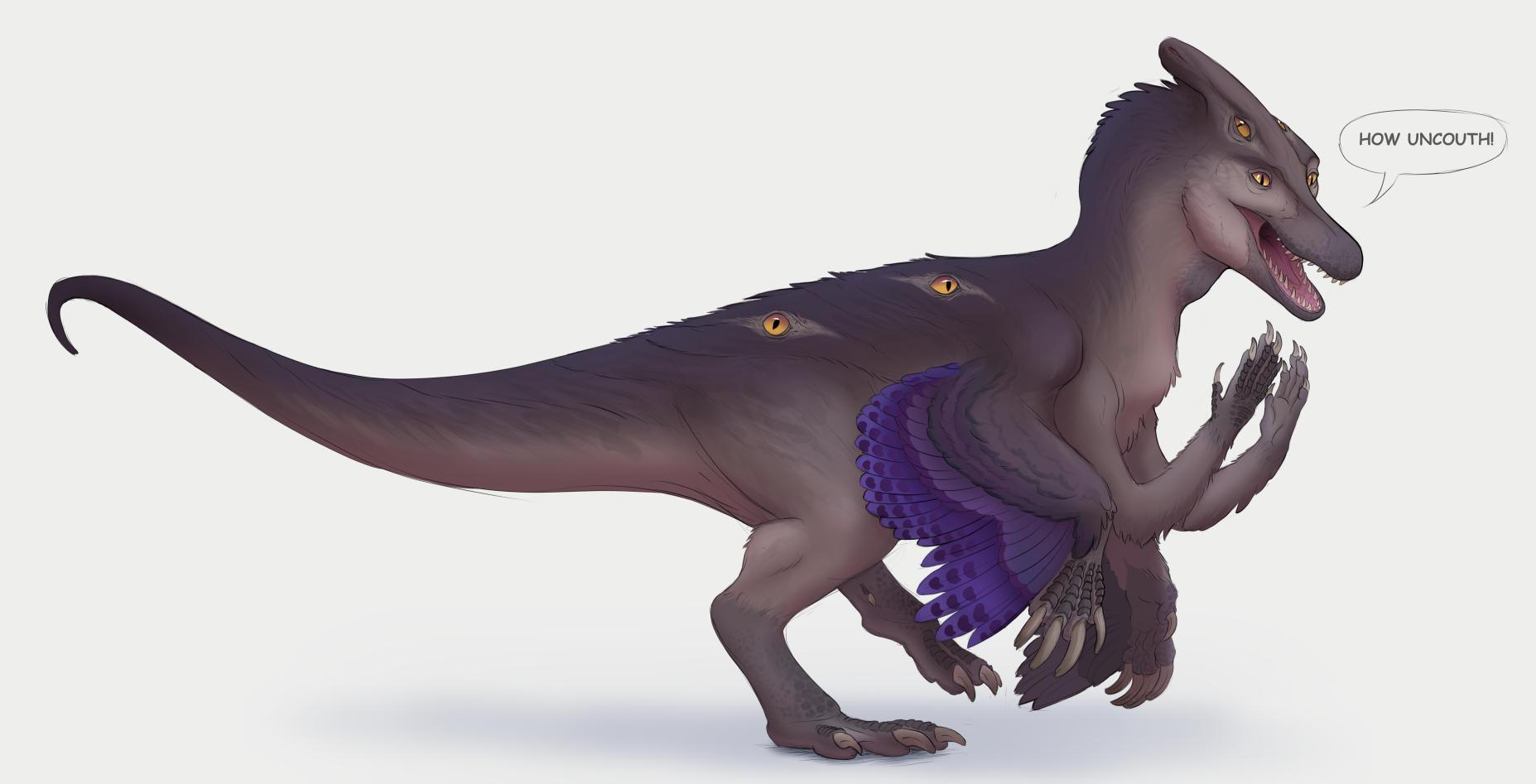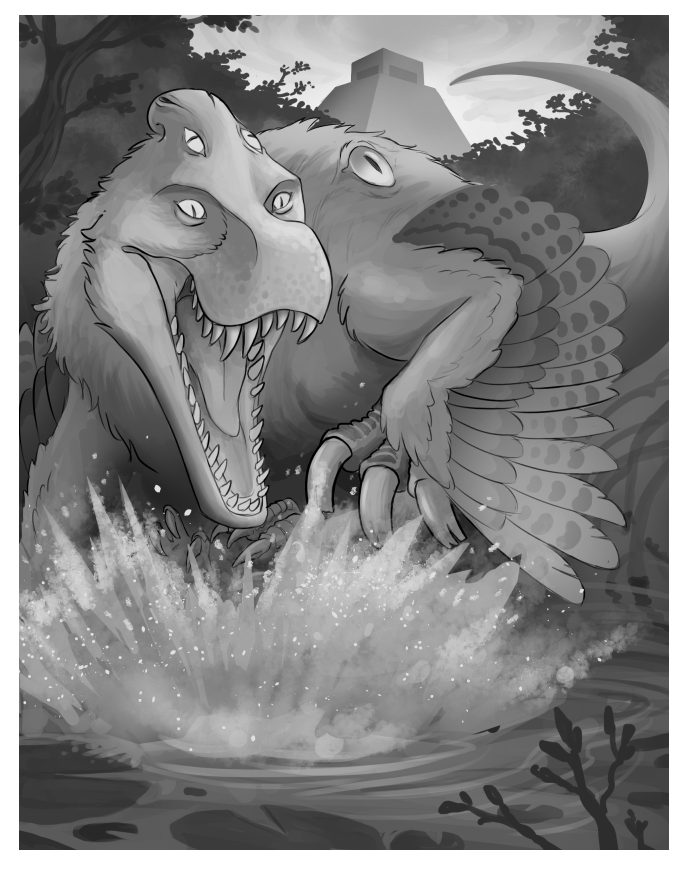"'I think you mean I get you all to myself.' With an impish grin that made Jess's stomach turn over, Layla slipped her fingertips underneath Brrdtbdak's feather ruff and began to scritch. Almost immediately, the Vreeüt shuddered, sat back on her haunches, and extended her neck, baring the soft, smooth feathers of her underbelly. Her neck swelled, wobbling visibly as Jess felt rather than heard the sound she was making. ‘Look at you,’ Layla purred, 'you filthy Brrd, sitting on your keelbone in public. And don't think I can't tell you're making a mating call, either!'"
Kanagen's The Floret in the Mirror, chapter 13
The vreeüt are a domesticated xenosophont species hailing from the Milky Way galaxy which share many similarities in appearance to the extinct utahraptors and similar species of prehistoric Terra. Unlike their earthling counterparts, they sport an excellent range of vision thanks to several additional pairs of eyes, ultraviolet plumage, an extra pair of limbs, and the intelligence and social structures to create an industrial society.
¶ Quick Info

Home System: Rrr'tach'üt
Home Planet: Aü'tkcha
Native Gravity: 0.94g
Year Length: 411 Terran standard days
Lifespan: In the wild, a vreeüt's expected lifespan was around 110 to 120 years, although now can expect longer lives thanks to affini xenoveterinary medicine. Vreeüt florets can be expected to live upwards of four centuries.
Circadian Rhythm: ~29 hours
Domesticated: ~2200 CE (roughly three to four centuries prior to the Human Domestication Treaty)
Names: In terran languages, most vreeüt names are adapted into something pronounceable without a syrinx (see note below), featuring a lot of sharp, choppy consonantal sounds with lots of (but not universally) rounded vowels.
Examples: Brrdbtdak, Tekshtmaret, Tothtarri, Driknatht
Editor's Note: Vreeüti languages are impossible to pronounce without a syrinx and an appropriate resonating cavity (though biomods exist to allow species without native access to such structures to do so). Vreeüti languages are highly morphologically distant from Terran languages; therefore, any representation of a Vreeüti word in Terran writing systems is necessarily a rough transliteration, and any terran-pronounceable adaptation of Vreeüti languages (known by the umbrella prefix "Terransong") are approximations at best.
All Vreeüti words in this article are transliterated based on the Rrrrchktüma language (in other words, Terransong Rrrrchktüma), which has the largest number of extant speakers. Terrans familiar with other Vreeüti languages (such as Rrrrtkaat or especially Rrrraü'ek, popularized by the program Sabine and Selenipedium) or their Terransong equivalents may adopt other conventions of transliteration.
¶ Appearance & Physiology

Vreeüt are hexapedal dromaeosaurid analogues from a star in the Centaurus Arm of the Milky Way. They’re large, heavily built, ground-dwelling omnivores (preferring a heavily fish-or-meat based diet), averaging 4-5 meters in length from head to tail with hips roughly 1.5-1.8 meters in height, massing roughly 280-350 kilograms. Females are larger than males, with a shaggier coat of feather analogues. Both males and females appear relatively drab to humans, as their coloration is primarily in the ultraviolet part of the visible light spectrum.
They have four pairs of eyes, two of which line their flanks and two of which sit on their head, one on the nasal ridge on top of their cranium, the other lower on their skull — only this last pair is arranged for binocular vision, while the rest provide a nearly 360 arc of peripheral vision (albeit at lower resolution than the binocular pair). All eyes possess nictitating membranes.
The ancestor species of the vreeüt were semiaquatic opportunistic carnivores, primarily piscivorous but perfectly able to ambush unwary prey at the shoreline or dig for bivalve analogues or eggs. Their medial limbs are highly adapted for digging, and bear large flat claws on four-fingers, along with a semi-opposable thumb for grasping large prey; on land, when not moving, vreeüt will often rest on these hands to better distribute their body weight, but do not walk on them. These limbs bear large feathers with extremely bright UV coloration, some of which shades into violet and even indigo highlights. Their foremost limbs are considerably smaller and more dextrous, with fully opposable thumbs and less developed feathers.
Vreeüt possess a structure analogous to a gular sac, which they use to greatly amplify the volume of their calls. A fully grown vreeüt can generate sounds in excess of 130 decibels, though with little vocal finesse; such calls are only used for long-distance infrasonic signaling, or in some Vreeüti forms of performance art. While they lack a larynx per se, the Vreeüti pharynx is extremely flexible; like some Terran avians, Vreeüt are natural mimics, able to reproduce many sounds, and so most vreeüt find it quite easy to speak other languages, even ones that ordinarily require different anatomy to do so.
¶ Culture & History

Most vreeüt ancestor species were largely solitary hunters, who reared their young before sending them off to establish their own territories. Their immediate ancestor species, however, developed the practice of limited familial association and cooperative hunting beyond adolescence; as family units stuck together and applied their knack for problem-solving to survival, they became more successful, and rapidly proliferated. Within a hundred thousand years, they went from regional apex predator to dominant species on their homeworld of Aü'tkcha.
Paleovreeütology has placed the development of language after this point; however, there is some evidence that earlier species may have had limited capacity for language and abstract problem-solving as well. Since these species are long-extinct, however (the closest relative of the vreeüt is a tree-dwelling omnivore not unlike a feathered flying squirrel), and since these species did not develop any form of writing, it's impossible to say for certain.
Early vreeüt transitioned rapidly to settled life — being territorial range hunters, it was only natural to build and improve one's home. Unlike terrans, however, this began not with agriculture but with aquaculture, with the digging of specialized canals and channels for the breeding and concentration of fish, bivalves, and similar food sources. Only much later in their history did the vreeüt begin cultivating plants, usually for flavoring or supplementing their primarily fish and meat diet.
Much of early Vreeüti history is carried on the back of epic song, which in traditional performance could reach an entire settlement even after those settlements grew into what terrans would recognize as cities. This oral history stretches back over 20,000 years, more than 15,000 years before the advent of writing kickstarted the rise of Vreeüti modernity.
Prior to contact with the Affini, the Vreeüt had developed an industrialized and globalized society based on commercial exchange between lineages, a term which is used here to represent the half-corporate, half-familial structures the Vreeüt preferred. Their settlements were no longer built close to the ground but rose in enormous steppe-pyramid-like arcologies, where water was pumped up, purified, and released to cascade through an entire artificial wetland ecosystem. This was the result of strict social segregation between economic classes; the wealthier one was, the closer to the apex one dwelt, and therefore the cleaner one's water. Those below lived in the literal backwash of their economic superiors.
Culturally, modern pre-contact vreeüt had become highly conservative, creating labyrinthine social rules which they believed divided them from mere animals (and, for the wealthy and high-status, from those of low status), and an elaborate culture of shame targeting those who violated them. Many of these rules proscribed otherwise natural impulses, such as mating dances or mating calls; consequently, over several centuries and continuing into the post-contact culture, actions transgressing these rules have become highly eroticized, even those with no historical connection to mating.
Following contact and subsequent domestication by the Affini, a few centuries before their discovery of the Terran Accord, Vreeüti society is now far more egalitarian and open than it once was. Affini engineering has completely transformed the cities of Aü'tkcha, and everyone enjoys water as pristine as only the very wealthiest could once dream of. Vreeüt have even ventured into space independently of the Affini, something that they might never have done without Compact assistance, as their size and sheer bulk makes them poorly adapted for high-G stresses. Apart from exploring and settling nearby star systems, of course, floret vreeüt have ventured all across the Compact with their owners, and can be found in much of the Milky Way, even as far as Rinan-Terran space.